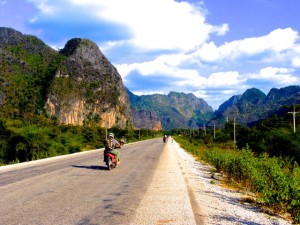 On the two-day-long slow boat from northern Thailand to Luang Prabang in Laos, my friend Laura and I met six other backpackers. None of us had a definite itinerary for Laos, nor any specific time constraints, so we all decided to travel through Laos together. In Luang Prabang we welcomed a nice Swedish couple into the mix and were now a group of eight consisting of two Americans, one Brit, two Dutch, two Swedes, and one Canadian. We slowly traveled South from Luang Prabang, and after exploring the capital of Vientienne, we took the advice of the two Dutch members of group, and were now in the town of Thakek in central Laos specifically to do “the loop,” a five day motorbike trip through jungles, mountains, and small villages that they read about in a Lonely Planet guidebook. Half of the group had never driven motorbikes before, so in hindsight it was a rather bold decision to set off alone into the jungle with so little experience. Nonetheless, we rented bikes for about $8 USD per day, loaded up our backpacks and set off.
On the two-day-long slow boat from northern Thailand to Luang Prabang in Laos, my friend Laura and I met six other backpackers. None of us had a definite itinerary for Laos, nor any specific time constraints, so we all decided to travel through Laos together. In Luang Prabang we welcomed a nice Swedish couple into the mix and were now a group of eight consisting of two Americans, one Brit, two Dutch, two Swedes, and one Canadian. We slowly traveled South from Luang Prabang, and after exploring the capital of Vientienne, we took the advice of the two Dutch members of group, and were now in the town of Thakek in central Laos specifically to do “the loop,” a five day motorbike trip through jungles, mountains, and small villages that they read about in a Lonely Planet guidebook. Half of the group had never driven motorbikes before, so in hindsight it was a rather bold decision to set off alone into the jungle with so little experience. Nonetheless, we rented bikes for about $8 USD per day, loaded up our backpacks and set off.
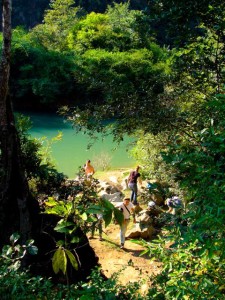 Within the first hour we had turned off the main road and were navigating a narrow dirt path more resembling more of a motor cross track than serviceable roadway in search of a waterfall and swimming area we had heard about back in Thakek. After a fruitless search for the waterfall, we settled on a riverbank where a couple of local teenagers were drinking beer, smoking cigarettes, and listening to a combination of Laos pop music and Linkin Park. Before jumping into the water we had a riveting debate on the possibilities that there were crocodiles because the scene was eerily similar to a “dramatic reenactment” in one of those “When Animals Attack” specials on tv. Ultimately we came the conclusion there were no crocodiles in Laos (possibly by asking the locals through convoluted hand signals and broken Laotian), and tentatively dove in. We all had a great time swimming and were soon back on our bikes refreshed and renewed.
Within the first hour we had turned off the main road and were navigating a narrow dirt path more resembling more of a motor cross track than serviceable roadway in search of a waterfall and swimming area we had heard about back in Thakek. After a fruitless search for the waterfall, we settled on a riverbank where a couple of local teenagers were drinking beer, smoking cigarettes, and listening to a combination of Laos pop music and Linkin Park. Before jumping into the water we had a riveting debate on the possibilities that there were crocodiles because the scene was eerily similar to a “dramatic reenactment” in one of those “When Animals Attack” specials on tv. Ultimately we came the conclusion there were no crocodiles in Laos (possibly by asking the locals through convoluted hand signals and broken Laotian), and tentatively dove in. We all had a great time swimming and were soon back on our bikes refreshed and renewed.
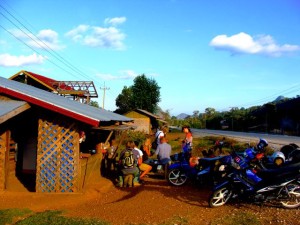 For the next four days we drove between seven and eleven hours per day through tiny villages where children would come running out of their homes waving, smiling, and shouting “sabadee” (hello) as we passed. The tiny villages were a simple collection of bamboo huts with thatch or sheet metal roofs and often had a small shop at the edge of the road with bags of snacks, water, and soda for anyone traveling through. Long hours on a tiny motorbike gets very uncomfortable so we stopped often as a group at these tiny shops. Through some basic Laotian phrases and a lot of pointing and hand signals you could get what you needed, and with our group all buying waters, sodas, and strange but often delicious snacks (dried water buffalo skin for example), we left each shop owner with a big smile for having easily provided them with a weeks worth of Kip (Laos currency).
For the next four days we drove between seven and eleven hours per day through tiny villages where children would come running out of their homes waving, smiling, and shouting “sabadee” (hello) as we passed. The tiny villages were a simple collection of bamboo huts with thatch or sheet metal roofs and often had a small shop at the edge of the road with bags of snacks, water, and soda for anyone traveling through. Long hours on a tiny motorbike gets very uncomfortable so we stopped often as a group at these tiny shops. Through some basic Laotian phrases and a lot of pointing and hand signals you could get what you needed, and with our group all buying waters, sodas, and strange but often delicious snacks (dried water buffalo skin for example), we left each shop owner with a big smile for having easily provided them with a weeks worth of Kip (Laos currency).
We realized by the second day that pavement was a luxury we were only going to have on the first and last day of the trip, so most of our driving included weaving through pot holes or figuring out the best way to ford the stream that was crossing the entire roadway. Some areas of the road had huge ramps that any dirt bike owner would envy. Unfortunately, on our little motorbikes stacked with gear, we didn’t have the luxury of attempting to go airborne.
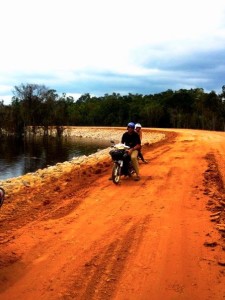 We soldiered on, through weaving roads in the jungle where at every turn I expected a tiger to jump out and knock me off my bike (they exist in the wild in that area of Laos). We went past cows, chickens, and water buffalo that made the road their home. At one point a disgruntled cow decided he did not like me passing him, so as I neared he turned and charged towards me. With a heavy jolt to the throttle and some quick turning I escaped unscathed. My dutch friend behind me had the pleasure of becoming the disgruntled cows next target, but I’m happy to say that he too came out fine, though I can’t say the same for everyone on the trip.
We soldiered on, through weaving roads in the jungle where at every turn I expected a tiger to jump out and knock me off my bike (they exist in the wild in that area of Laos). We went past cows, chickens, and water buffalo that made the road their home. At one point a disgruntled cow decided he did not like me passing him, so as I neared he turned and charged towards me. With a heavy jolt to the throttle and some quick turning I escaped unscathed. My dutch friend behind me had the pleasure of becoming the disgruntled cows next target, but I’m happy to say that he too came out fine, though I can’t say the same for everyone on the trip.
On day one, our English friend hit some loose rocks as a truck turned out in front of her and she went skidding down the gravel next to the road. I was the first to arrive at the scene behind her and by then a whole Laos family had come out of their house and were cleaning her up and hammering away at her bike to fix the dents. She had a lot of scrapes along her arms and back, but luckily nothing deep or worrisome. On day two I got a flat tire while climbing up a mountain pass, but with a simple wave of the hand and some gestures to show the problem, a man (in what looked like an army truck) stopped, helped us load the bike into the bed and was off, driving myself and the bike to the shop in the nearest town. As almost everyone in Southeast Asia drives a motorbike, even the tiniest village has a repair shop. Ten minutes after arriving with a flat tire, and for only one dollar, I was back on the road. A couple of days later, two others had some engine problems, but once again the surplus of motorbike shops and the incredible generosity of everyone we met turned what seemed like major problems into only minor inconveniences. On day four our Canadian friend swerved to avoid a chicken in the road (a common problem throughout the trip) and in doing so lost his footing, allowing his foot to scrape itself along the ground. He had a big gash on his toe, but again it was nothing urgent.
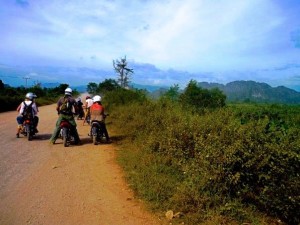 We finished out day five in luxury, as the last 200 km were paved and we could get our little bikes up to about 100-110 km/hr. We raced along the final stretch, arriving back in Thakek before dark. Over the course of five days out in the wilderness, there was not one bike in the shape that we got them in, but somehow we managed to avoid any extra charges. Overall, it was an amazing test of endurance and self reliance, with sights and experiences that I can’t even begin to put into words.
We finished out day five in luxury, as the last 200 km were paved and we could get our little bikes up to about 100-110 km/hr. We raced along the final stretch, arriving back in Thakek before dark. Over the course of five days out in the wilderness, there was not one bike in the shape that we got them in, but somehow we managed to avoid any extra charges. Overall, it was an amazing test of endurance and self reliance, with sights and experiences that I can’t even begin to put into words.